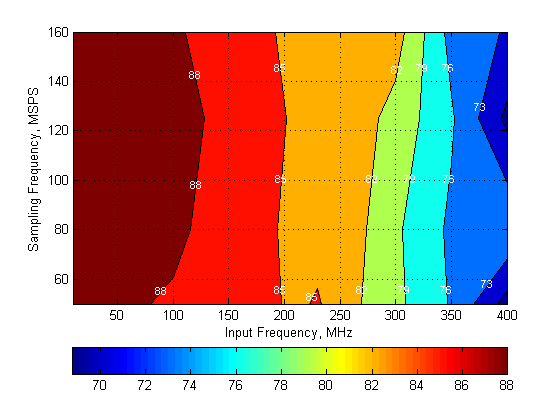ZHCSDC0A May 2014 – January 2015 ADC34J22 , ADC34J23 , ADC34J24 , ADC34J25
PRODUCTION DATA.
- 1 特性
- 2 应用
- 3 说明
- 4 修订历史记录
- 5 Device Comparison Table
- 6 Pin Configuration and Functions
-
7 Specifications
- 7.1 Absolute Maximum Ratings
- 7.2 ESD Ratings
- 7.3 Recommended Operating Conditions
- 7.4 Summary of Special Mode Registers
- 7.5 Thermal Information
- 7.6 Electrical Characteristics: ADC34J24, ADC34J25
- 7.7 Electrical Characteristics: ADC34J22, ADC34J23
- 7.8 Electrical Characteristics: General
- 7.9 AC Performance: ADC34J25
- 7.10 AC Performance: ADC34J24
- 7.11 AC Performance: ADC34J23
- 7.12 AC Performance: ADC34J22
- 7.13 Digital Characteristics
- 7.14 Timing Characteristics
- 7.15 Typical Characteristics: ADC34J25
- 7.16 Typical Characteristics: ADC34J24
- 7.17 Typical Characteristics: ADC34J23
- 7.18 Typical Characteristics: ADC34J22
- 7.19 Typical Characteristics: Common Plots
- 7.20 Typical Characteristics: Contour Plots
- 8 Parameter Measurement Information
- 9 Detailed Description
- 10Application and Implementation
- 11Power-Supply Recommendations
- 12Layout
- 13器件和文档支持
- 14机械封装和可订购信息
7 Specifications
7.1 Absolute Maximum Ratings
over operating free-air temperature range (unless otherwise noted) (1)| MIN | MAX | UNIT | ||
|---|---|---|---|---|
| Supply voltage range, AVDD | –0.3 | 2.1 | V | |
| Supply voltage range, DVDD | –0.3 | 2.1 | V | |
| Voltage applied to input pins: | INAP, INBP, INCP, INDP, INAM, INBM, INCM, INDM | –0.3 | Minimum (AVDD + 0.3, 2.1) |
V |
| CLKP, CLKM(2) | –0.3 | Minimum (AVDD + 0.3, 2.1) |
V | |
| SYSREFP, SYSREFM, SYNCP~, SYNCM~ | –0.3 | Minimum (AVDD + 0.3, 2.1) |
V | |
| SCLK, SEN, SDATA, RESET, PDN | –0.3 | 3.6 | V | |
| Temperature | Operating free-air, TA | –40 | 85 | °C |
| Operating junction, TJ | 125 | °C | ||
| Storage, Tstg | –65 | 150 | °C | |
(1) Stresses beyond those listed under Absolute Maximum Ratings may cause permanent damage to the device. These are stress ratings only, which do not imply functional operation of the device at these or any other conditions beyond those indicated under Recommended Operating Conditions. Exposure to absolute-maximum-rated conditions for extended periods may affect device reliability.
(2) When AVDD is turned off, TI recommends switching off the input clock (or ensuring the voltage on CLKP, CLKM is less than |0.3 V|). This configuration prevents the ESD protection diodes at the clock input pins from turning on.
7.2 ESD Ratings
| VALUE | UNIT | |||
|---|---|---|---|---|
| V(ESD) | Electrostatic discharge | Human body model (HBM), per ANSI/ESDA/JEDEC JS-001(1) | ±2000 | V |
(1) JEDEC document JEP155 states that 500-V HBM allows safe manufacturing with a standard ESD control process.
7.3 Recommended Operating Conditions(2)
over operating free-air temperature range (unless otherwise noted)| MIN | NOM | MAX | UNIT | |||
|---|---|---|---|---|---|---|
| SUPPLIES | ||||||
| AVDD | Analog supply voltage range | 1.7 | 1.8 | 1.9 | V | |
| DVDD | Digital supply voltage range | 1.7 | 1.8 | 1.9 | V | |
| ANALOG INPUT | ||||||
| VID | Differential input voltage | For input frequencies < 450 MHz | 2 | VPP | ||
| For input frequencies < 600 MHz | 1 | VPP | ||||
| VIC | Input common-mode voltage | VCM ± 0.025 | V | |||
| CLOCK INPUT | ||||||
| Input clock frequency | Sampling clock frequency | 25 | 160(1) | MSPS | ||
| Input clock amplitude (differential) | Sine wave, ac-coupled | 0.2 | 1.5 | V | ||
| LPECL, ac-coupled | 1.6 | V | ||||
| LVDS, ac-coupled | 0.7 | V | ||||
| Input clock duty cycle | 35 | 50 | 65 | % | ||
| Input clock common-mode voltage | 0.95 | V | ||||
| DIGITAL OUTPUTS | ||||||
| CLOAD | Maximum external load capacitance from each output pin to GND | 3.3 | pF | |||
| RLOAD | Single-ended load resistance | 100 | Ω | |||
(1) With the clock divider enabled by default for divide-by-1. Maximum sampling clock frequency for the divide-by-4 option is 640 MSPS.
(2) After power-up, to reset the device for the first time, only use the RESET pin; see the Register Initialization section.
7.4 Summary of Special Mode Registers
Table 1 lists the location, value, and functions of special mode registers in the device.
Table 1. Special Modes Summary
| MODE | LOCATION | VALUE AND FUNCTION | |
|---|---|---|---|
| Dither mode | DIS DITH CHA | 01h [7:6], 134h[5,3] | Creates a noise floor cleaner and improves SFDR; see the Internal Dither Algorithm section. 0000 = Dither disabled 1111 = Dither enabled |
| DIS DITH CHB | 01h [5:4], 434h[5,3] | ||
| DIS DITH CHC | 01h [3:2], 534h[5,3] | ||
| DIS DITH CHD | 01h [1:0], 234h[5,3] | ||
| Special mode 1 | SPECIAL MODE 1 CHA | 06h[4:2] | Use for better HD3. 000 = Default after reset 010 = Use for frequency < 120 MHz 111 = Use for frequency > 120 MHz |
| SPECIAL MODE 1 CHB | 07h[4:2] | ||
| SPECIAL MODE 1 CHC | 08h[4:2] | ||
| SPECIAL MODE 1 CHD | 09h[4:2] | ||
| Special mode 2 | SPECIAL MODE 2 CHA | 122h[1:0] | Helps improve HD2. 00 = Default after reset 11 = Improves HD2 |
| SPECIAL MODE 2 CHB | 422h[1:0] | ||
| SPECIAL MODE 2 CHC | 522h[1:0] | ||
| SPECIAL MODE 2 CHD | 222h[1:0] | ||
7.5 Thermal Information
| THERMAL METRIC(1) | ADC34J2x | UNIT | |
|---|---|---|---|
| RGZ (VQFN) | |||
| 48 PINS | |||
| RθJA | Junction-to-ambient thermal resistance | 25.7 | °C/W |
| RθJC(top) | Junction-to-case (top) thermal resistance | 18.9 | |
| RθJB | Junction-to-board thermal resistance | 3.0 | |
| ψJT | Junction-to-top characterization parameter | 0.2 | |
| ψJB | Junction-to-board characterization parameter | 3 | |
| RθJC(bot) | Junction-to-case (bottom) thermal resistance | 0.5 | |
(1) For more information about traditional and new thermal metrics, see the IC Package Thermal Metrics application report, SPRA953.
7.6 Electrical Characteristics: ADC34J24, ADC34J25
Typical values are at TA = 25°C, full temperature range is TMIN = –40°C to TMAX = 85°C, maximum sampling rate, 50% clock duty cycle, AVDD = DVDD = 1.8 V, and –1-dBFS differential input, unless otherwise noted.| PARAMETER | ADC34J24 | ADC34J25 | UNIT | |||||
|---|---|---|---|---|---|---|---|---|
| MIN | TYP | MAX | MIN | TYP | MAX | |||
| ADC clock frequency | 125 | 160 | MSPS | |||||
| Resolution | 12 | 12 | Bits | |||||
| 1.8-V analog supply (AVDD) current | 318 | 490 | 354 | 490 | mA | |||
| 1.8-V digital supply current | 79 | 150 | 97 | 150 | mA | |||
| Total power dissipation | 715 | 1010 | 812 | 1010 | mW | |||
| Global power-down dissipation | 22 | 22 | mW | |||||
| Wake-up time from global power-down | 85 | 100 | 85 | 100 | µs | |||
| Standby power-down dissipation | 177 | 185 | mW | |||||
| Wake-up time from standby power-down | 35 | 300 | 35 | 300 | µs | |||
7.7 Electrical Characteristics: ADC34J22, ADC34J23
Typical values are at TA = 25°C, full temperature range is TMIN = –40°C to TMAX = 85°C, maximum sampling rate, 50% clock duty cycle, AVDD = DVDD = 1.8 V, and –1-dBFS differential input, unless otherwise noted.| PARAMETER | ADC34J22 | ADC34J23 | UNIT | |||||
|---|---|---|---|---|---|---|---|---|
| MIN | TYP | MAX | MIN | TYP | MAX | |||
| ADC clock frequency | 50 | 80 | MSPS | |||||
| Resolution | 12 | 12 | Bits | |||||
| 1.8-V analog supply current | 233 | 490 | 269 | 490 | mA | |||
| 1.8-V digital supply current | 39 | 150 | 56 | 150 | mA | |||
| Total power dissipation | 491 | 1010 | 584 | 1010 | mW | |||
| Global power-down dissipation | 22 | 22 | mW | |||||
| Wake-up time from global power-down | 85 | 100 | 85 | 100 | µs | |||
| Standby power-down dissipation | 155 | 166 | mW | |||||
| Wake-up time from standby power-down | 35 | 300 | 35 | 300 | µs | |||
7.8 Electrical Characteristics: General
Typical values are at TA = 25°C, full temperature range is TMIN = –40°C to TMAX = 85°C, Maximum sampling rate, 50% clock duty cycle, AVDD = DVDD = 1.8 V, and –1-dBFS differential input, unless otherwise noted.| PARAMETER | TEST CONDITIONS | MIN | TYP | MAX | UNIT | ||
|---|---|---|---|---|---|---|---|
| ANALOG INPUT | |||||||
| Differential input full-scale | 2.0 | VPP | |||||
| ri | Input resistance | Differential at dc | 6.5 | kΩ | |||
| ci | Input capacitance | Differential at dc | 5.2 | pF | |||
| VOC(VCM) | VCM common-mode voltage output | 0.95 | V | ||||
| VCM output current capability | 10 | mA | |||||
| Input common-mode current | Per analog input pin | 1.5 | µA/MSPS | ||||
| Analog input bandwidth (3 dB) | 50-Ω differential source driving 50-Ω termination across INP and INM | 450 | MHz | ||||
| DC ACCURACY | |||||||
| EO | Offset error | –20 | 20 | mV | |||
| EG(REF) | Gain error as a result of internal reference inaccuracy alone | –3 | 3 | %FS | |||
| EG(CHAN) | Gain error of channel alone | ±1 | %FS | ||||
| CHANNEL-TO-CHANNEL ISOLATION | |||||||
| Crosstalk(1) | fIN = 10 MHz | Near channel | 105 | dB | |||
| Far channel | 105 | dB | |||||
| fIN = 100 MHz | Near channel | 95 | dB | ||||
| Far channel | 105 | dB | |||||
| fIN = 200 MHz | Near channel | 94 | dB | ||||
| Far channel | 105 | dB | |||||
| fIN = 230 MHz | Near channel | 93 | dB | ||||
| Far channel | 105 | dB | |||||
| fIN = 300 MHz | Near channel | 85 | dB | ||||
| Far channel | 105 | dB | |||||
(1) Crosstalk is measured with a –1-dBFS input signal on aggressor channel and no input on victim channel.
7.9 AC Performance: ADC34J25
Typical values are at TA = 25°C, full temperature range is TMIN = –40°C to TMAX = 85°C, ADC sampling rate = 160 MSPS, 50% clock duty cycle, AVDD = DVDD = 1.8 V, and –1-dBFS differential input, unless otherwise noted.| PARAMETER | TEST CONDITIONS | ADC34J25 (fS = 160 MSPS) | UNIT | ||||||
|---|---|---|---|---|---|---|---|---|---|
| DITHER ON | DITHER OFF | ||||||||
| MIN | TYP | MAX | MIN | TYP | MAX | ||||
| DYNAMIC AC CHARACTERISTICS | |||||||||
| SNR | Signal-to-noise ratio | fIN = 10 MHz | 70.2 | 70.4 | dBFS | ||||
| fIN = 70 MHz | 68.5 | 69.6 | 69.9 | ||||||
| fIN = 100 MHz | 69.3 | 69.6 | |||||||
| fIN = 170 MHz | 68.4 | 68.9 | |||||||
| fIN = 230 MHz | 67.5 | 68.1 | |||||||
| NSD | Noise spectral density (averaged across Nyquist zone) |
fIN = 10 MHz | 149.2 | 149.4 | dBFS/Hz | ||||
| fIN = 70 MHz | 147.5 | 148.6 | 148.9 | ||||||
| fIN = 100 MHz | 148.3 | 148.6 | |||||||
| fIN = 170 MHz | 147.4 | 147.9 | |||||||
| fIN = 230 MHz | 146.5 | 147.1 | |||||||
| SINAD | Signal-to-noise and distortion ratio | fIN = 10 MHz | 70.1 | 70.3 | dBFS | ||||
| fIN = 70 MHz | 67.6 | 69.5 | 69.7 | ||||||
| fIN = 100 MHz | 69.2 | 69.4 | |||||||
| fIN = 170 MHz | 68.2 | 68.6 | |||||||
| fIN = 230 MHz | 67.2 | 67.5 | |||||||
| ENOB | Effective number of bits | fIN = 10 MHz | 11.4 | 11.4 | Bits | ||||
| fIN = 70 MHz | 10.9 | 11.3 | 11.3 | ||||||
| fIN = 100 MHz | 11.2 | 11.3 | |||||||
| fIN = 170 MHz | 11.1 | 11.1 | |||||||
| fIN = 230 MHz | 10.9 | 10.9 | |||||||
| SFDR | Spurious-free dynamic range | fIN = 10 MHz | 85 | 86 | dBc | ||||
| fIN = 70 MHz | 81 | 86 | 85 | ||||||
| fIN = 100 MHz | 86 | 87 | |||||||
| fIN = 170 MHz | 85 | 84 | |||||||
| fIN = 230 MHz | 81 | 80 | |||||||
| HD2 | Second harmonic distortion | fIN = 10 MHz | 91 | 92 | dBc | ||||
| fIN = 70 MHz | 81 | 94 | 93 | ||||||
| fIN = 100 MHz | 93 | 91 | |||||||
| fIN = 170 MHz | 83 | 83 | |||||||
| fIN = 230 MHz | 81 | 79 | |||||||
| HD3 | Third harmonic distortion | fIN = 10 MHz | 85 | 86 | dBc | ||||
| fIN = 70 MHz | 81 | 85 | 85 | ||||||
| fIN = 100 MHz | 86 | 87 | |||||||
| fIN = 170 MHz | 93 | 87 | |||||||
| fIN = 230 MHz | 85 | 82 | |||||||
| Non HD2, HD3 |
Spurious-free dynamic range (excluding HD2, HD3) | fIN = 10 MHz | 98 | 94 | dBc | ||||
| fIN = 70 MHz | 87 | 97 | 94 | ||||||
| fIN = 100 MHz | 96 | 93 | |||||||
| fIN = 170 MHz | 92 | 92 | |||||||
| fIN = 230 MHz | 90 | 89 | |||||||
| THD | Total harmonic distortion | fIN = 10 MHz | 84 | 83 | dBc | ||||
| fIN = 70 MHz | 76.5 | 84 | 83 | ||||||
| fIN = 100 MHz | 84 | 84 | |||||||
| fIN = 170 MHz | 82 | 80 | |||||||
| fIN = 230 MHz | 78 | 76 | |||||||
| IMD3 | Third-order intermodulation distortion | fIN1 = 45 MHz, fIN2 = 50 MHz |
92 | 92 | dBFS | ||||
| fIN1 = 185 MHz, fIN2 = 190 MHz |
87 | 87 | |||||||
7.10 AC Performance: ADC34J24
Typical values are at TA = 25°C, full temperature range is TMIN = –40°C to TMAX = 85°C, ADC sampling rate = 125 MSPS, 50% clock duty cycle, AVDD = DVDD = 1.8 V, and –1-dBFS differential input, unless otherwise noted.| PARAMETER | TEST CONDITIONS | ADC34J24 (fS = 125 MSPS) | UNIT | ||||||
|---|---|---|---|---|---|---|---|---|---|
| DITHER ON | DITHER OFF | ||||||||
| MIN | TYP | MAX | MIN | TYP | MAX | ||||
| DYNAMIC AC CHARACTERISTICS | |||||||||
| SNR | Signal-to-noise ratio | fIN = 10 MHz | 70.3 | 70.6 | dBFS | ||||
| fIN = 70 MHz | 68.8 | 70.1 | 70.4 | ||||||
| fIN = 100 MHz | 69.9 | 70.2 | |||||||
| fIN = 170 MHz | 69.1 | 69.7 | |||||||
| fIN = 230 MHz | 68.6 | 69.1 | |||||||
| NSD | Noise spectral density (averaged across Nyquist zone) |
fIN = 10 MHz | 148.3 | 148.6 | dBFS/Hz | ||||
| fIN = 70 MHz | 146.8 | 148.1 | 148.4 | ||||||
| fIN = 100 MHz | 147.9 | 148.2 | |||||||
| fIN = 170 MHz | 147.1 | 147.7 | |||||||
| fIN = 230 MHz | 146.6 | 147.1 | |||||||
| SINAD | Signal-to-noise and distortion ratio | fIN = 10 MHz | 70.3 | 70.5 | dBFS | ||||
| fIN = 70 MHz | 67.6 | 70 | 70.3 | ||||||
| fIN = 100 MHz | 69.8 | 70.1 | |||||||
| fIN = 170 MHz | 68.9 | 69.3 | |||||||
| fIN = 230 MHz | 68.4 | 68.8 | |||||||
| ENOB | Effective number of bits | fIN = 10 MHz | 11.4 | 11.4 | Bits | ||||
| fIN = 70 MHz | 10.9 | 11.4 | 11.4 | ||||||
| fIN = 100 MHz | 11.3 | 11.4 | |||||||
| fIN = 170 MHz | 11.2 | 11.3 | |||||||
| fIN = 230 MHz | 11.1 | 11.1 | |||||||
| SFDR | Spurious-free dynamic range | fIN = 10 MHz | 94 | 92 | dBc | ||||
| fIN = 70 MHz | 81 | 93 | 91 | ||||||
| fIN = 100 MHz | 93 | 92 | |||||||
| fIN = 170 MHz | 85 | 83 | |||||||
| fIN = 230 MHz | 83 | 82 | |||||||
| HD2 | Second harmonic distortion | fIN = 10 MHz | 93 | 93 | dBc | ||||
| fIN = 70 MHz | 81 | 94 | 94 | ||||||
| fIN = 100 MHz | 92 | 92 | |||||||
| fIN = 170 MHz | 83 | 83 | |||||||
| fIN = 230 MHz | 82 | 82 | |||||||
| HD3 | Third harmonic distortion | fIN = 10 MHz | 96 | 93 | dBc | ||||
| fIN = 70 MHz | 83 | 94 | 91 | ||||||
| fIN = 100 MHz | 95 | 93 | |||||||
| fIN = 170 MHz | 88 | 86 | |||||||
| fIN = 230 MHz | 87 | 88 | |||||||
| Non HD2, HD3 |
Spurious-free dynamic range (excluding HD2, HD3) | fIN = 10 MHz | 99 | 95 | dBc | ||||
| fIN = 70 MHz | 87 | 98 | 95 | ||||||
| fIN = 100 MHz | 97 | 95 | |||||||
| fIN = 170 MHz | 97 | 92 | |||||||
| fIN = 230 MHz | 95 | 92 | |||||||
| THD | Total harmonic distortion | fIN = 10 MHz | 89 | 87 | dBc | ||||
| fIN = 70 MHz | 76.5 | 89 | 87 | ||||||
| fIN = 100 MHz | 89 | 87 | |||||||
| fIN = 170 MHz | 82 | 80 | |||||||
| fIN = 230 MHz | 81 | 80 | |||||||
| IMD3 | Third-order intermodulation distortion | fIN1 = 45 MHz, fIN2 = 50 MHz |
97 | 97 | dBFS | ||||
| fIN1 = 185 MHz, fIN2 = 190 MHz |
89 | 89 | |||||||
7.11 AC Performance: ADC34J23
Typical values are at TA = 25°C, full temperature range is TMIN = –40°C to TMAX = 85°C, ADC sampling rate = 80 MSPS, 50% clock duty cycle, AVDD = DVDD = 1.8 V, and –1-dBFS differential input, unless otherwise noted.| PARAMETER | TEST CONDITIONS | ADC34J23 (fS = 80 MSPS) | UNIT | ||||||
|---|---|---|---|---|---|---|---|---|---|
| DITHER ON | DITHER OFF | ||||||||
| MIN | TYP | MAX | MIN | TYP | MAX | ||||
| DYNAMIC AC CHARACTERISTICS | |||||||||
| SNR | Signal-to-noise ratio | fIN = 10 MHz | 70.2 | 70.4 | dBFS | ||||
| fIN = 70 MHz | 68.7 | 70 | 70.3 | ||||||
| fIN = 100 MHz | 69.9 | 70.1 | |||||||
| fIN = 170 MHz | 69.3 | 69.6 | |||||||
| fIN = 230 MHz | 68.7 | 68.9 | |||||||
| NSD | Noise spectral density (averaged across Nyquist zone) |
fIN = 10 MHz | 146.1 | 146.3 | dBFS/Hz | ||||
| fIN = 70 MHz | 144.8 | 145.9 | 146.2 | ||||||
| fIN = 100 MHz | 145.8 | 146.0 | |||||||
| fIN = 170 MHz | 145.2 | 145.5 | |||||||
| fIN = 230 MHz | 144.6 | 144.8 | |||||||
| SINAD | Signal-to-noise and distortion ratio | fIN = 10 MHz | 70.2 | 70.3 | dBFS | ||||
| fIN = 70 MHz | 67.6 | 70 | 70.2 | ||||||
| fIN = 100 MHz | 69.8 | 69.9 | |||||||
| fIN = 170 MHz | 69.1 | 69.3 | |||||||
| fIN = 230 MHz | 68.2 | 68.4 | |||||||
| ENOB | Effective number of bits | fIN = 10 MHz | 11.4 | 11.4 | Bits | ||||
| fIN = 70 MHz | 10.9 | 11.4 | 11.4 | ||||||
| fIN = 100 MHz | 11.3 | 11.3 | |||||||
| fIN = 170 MHz | 11.2 | 11.3 | |||||||
| fIN = 230 MHz | 11.1 | 11.1 | |||||||
| SFDR | Spurious-free dynamic range | fIN= 10 MHz | 95 | 91 | dBc | ||||
| fIN = 70 MHz | 82 | 95 | 90 | ||||||
| fIN = 100 MHz | 90 | 89 | |||||||
| fIN = 170 MHz | 87 | 84 | |||||||
| fIN = 230 MHz | 80 | 80 | |||||||
| HD2 | Second harmonic distortion | fIN = 10 MHz | 95 | 95 | dBc | ||||
| fIN = 70 MHz | 82 | 95 | 94 | ||||||
| fIN = 100 MHz | 91 | 92 | |||||||
| fIN = 170 MHz | 83 | 83 | |||||||
| fIN = 230 MHz | 81 | 82 | |||||||
| HD3 | Third harmonic distortion | fIN = 10 MHz | 99 | 94 | dBc | ||||
| fIN = 70 MHz | 83 | 101 | 94 | ||||||
| fIN = 100 MHz | 91 | 90 | |||||||
| fIN = 170 MHz | 92 | 90 | |||||||
| fIN = 230 MHz | 80 | 80 | |||||||
| Non HD2, HD3 |
Spurious-free dynamic range (excluding HD2, HD3) | fIN = 10 MHz | 98 | 92 | dBc | ||||
| fIN = 70 MHz | 87 | 98 | 92 | ||||||
| fIN = 100 MHz | 97 | 91 | |||||||
| fIN = 170 MHz | 96 | 91 | |||||||
| fIN = 230 MHz | 93 | 91 | |||||||
| THD | Total harmonic distortion | fIN = 10 MHz | 91 | 86 | dBc | ||||
| fIN = 70 MHz | 76.5 | 91 | 86 | ||||||
| fIN = 100 MHz | 87 | 84 | |||||||
| fIN = 170 MHz | 82 | 81 | |||||||
| fIN = 230 MHz | 77 | 77 | |||||||
| IMD3 | Third-order intermodulation distortion | fIN1 = 45 MHz, fIN2 = 50 MHz |
95 | 95 | dBFS | ||||
| fIN1 = 185 MHz, fIN2 = 190 MHz |
88 | 88 | |||||||
7.12 AC Performance: ADC34J22
Typical values are at TA = 25°C, full temperature range is TMIN = –40°C to TMAX = 85°C, ADC sampling rate = 50 MSPS, 50% clock duty cycle, AVDD = DVDD = 1.8 V, and –1-dBFS differential input, unless otherwise noted.| PARAMETER | TEST CONDITIONS | ADC34J22 (fS = 50 MSPS) | UNIT | ||||||
|---|---|---|---|---|---|---|---|---|---|
| DITHER ON | DITHER OFF | ||||||||
| MIN | TYP | MAX | MIN | TYP | MAX | ||||
| DYNAMIC AC CHARACTERISTICS | |||||||||
| SNR | Signal-to-noise ratio | fIN = 10 MHz | 69.3 | 70.2 | 70.5 | dBFS | |||
| fIN = 70 MHz | 70 | 70.3 | |||||||
| fIN = 100 MHz | 69.9 | 70.2 | |||||||
| fIN = 170 MHz | 69.3 | 69.5 | |||||||
| fIN = 230 MHz | 67.9 | 68 | |||||||
| NSD | Noise spectral density (averaged across Nyquist zone) |
fIN = 10 MHz | 143.3 | 144.2 | 144.5 | dBFS/Hz | |||
| fIN = 70 MHz | 144 | 144.3 | |||||||
| fIN = 100 MHz | 143.9 | 144.2 | |||||||
| fIN = 170 MHz | 143.3 | 143.5 | |||||||
| fIN = 230 MHz | 141.9 | 142 | |||||||
| SINAD | Signal-to-noise and distortion ratio | fIN = 10 MHz | 67.6 | 70.2 | 70.4 | dBFS | |||
| fIN = 70 MHz | 69.9 | 70.1 | |||||||
| fIN = 100 MHz | 69.8 | 70 | |||||||
| fIN = 170 MHz | 69.1 | 69.3 | |||||||
| fIN = 230 MHz | 67.5 | 67.6 | |||||||
| ENOB | Effective number of bits | fIN = 10 MHz | 10.9 | 11.4 | 11.4 | Bits | |||
| fIN = 70 MHz | 11.3 | 11.3 | |||||||
| fIN = 100 MHz | 11.3 | 11.3 | |||||||
| fIN = 170 MHz | 11.2 | 11.2 | |||||||
| fIN = 230 MHz | 10.9 | 10.9 | |||||||
| SFDR | Spurious-free dynamic range | fIN = 10 MHz | 84.5 | 95 | 91 | dBc | |||
| fIN = 70 MHz | 93 | 90 | |||||||
| fIN = 100 MHz | 90 | 89 | |||||||
| fIN = 170 MHz | 85 | 84 | |||||||
| fIN = 230 MHz | 80 | 80 | |||||||
| HD2 | Second harmonic distortion | fIN = 10 MHz | 84.5 | 94 | 93 | dBc | |||
| fIN = 70 MHz | 93 | 93 | |||||||
| fIN = 100 MHz | 90 | 90 | |||||||
| fIN = 170 MHz | 83 | 83 | |||||||
| fIN = 230 MHz | 81 | 81 | |||||||
| HD3 | Third harmonic distortion | fIN = 10 MHz | 84.5 | 102 | 96 | dBc | |||
| fIN = 70 MHz | 94 | 92 | |||||||
| fIN = 100 MHz | 90 | 89 | |||||||
| fIN = 170 MHz | 91 | 90 | |||||||
| fIN = 230 MHz | 80 | 80 | |||||||
| Non HD2, HD3 |
Spurious-free dynamic range (excluding HD2, HD3) | fIN = 10 MHz | 87 | 98 | 92 | dBc | |||
| fIN = 70 MHz | 97 | 92 | |||||||
| fIN = 100 MHz | 96 | 92 | |||||||
| fIN = 170 MHz | 95 | 91 | |||||||
| fIN = 230 MHz | 93 | 91 | |||||||
| THD | Total harmonic distortion | fIN = 10 MHz | 76.5 | 91 | 86 | dBc | |||
| fIN = 70 MHz | 89 | 85 | |||||||
| fIN = 100 MHz | 86 | 84 | |||||||
| fIN = 170 MHz | 82 | 81 | |||||||
| fIN = 230 MHz | 77 | 77 | |||||||
| IMD3 | Third-order intermodulation distortion | fIN1 = 45 MHz, fIN2 = 50 MHz |
93 | 93 | dBFS | ||||
| fIN1 = 185 MHz, fIN2 = 190 MHz |
86 | 86 | |||||||
7.13 Digital Characteristics
The dc specifications refer to the condition where the digital outputs are not switching, but are permanently at a valid logic level 0 or 1. AVDD = DVDD = 1.8 V and –1-dBFS differential input, unless otherwise noted.| PARAMETER | TEST CONDITIONS | MIN | TYP | MAX | UNIT | |
|---|---|---|---|---|---|---|
| DIGITAL INPUTS (RESET, SCLK, SEN, SDATA, PDN)(1) | ||||||
| VIH | High-level input voltage | All digital inputs support 1.8-V and 3.3-V logic levels | 1.2 | V | ||
| VIL | Low-level input voltage | All digital inputs support 1.8-V and 3.3-V logic levels | 0.4 | V | ||
| IIH | High-level input current | SEN | 0 | µA | ||
| RESET, SCLK, SDATA, PDN | 10 | µA | ||||
| IIL | Low-level input current | SEN | 10 | µA | ||
| RESET, SCLK, SDATA, PDN | 0 | µA | ||||
| DIGITAL INPUTS (SYNCP~, SYNCM~, SYSREFP, SYSREFM) | ||||||
| VIH | High-level input voltage | 1.3 | V | |||
| VIL | Low-level input voltage | 0.5 | V | |||
| V(CM_DIG) | Common-mode voltage for SYNC~ and SYSREF | 0.9 | V | |||
| DIGITAL OUTPUTS (SDOUT, OVRA, OVRB, OVRC, OVRD) | ||||||
| VOH | High-level output voltage | DVDD – 0.1 | DVDD | V | ||
| VOL | Low-level output voltage | 0.1 | V | |||
| DIGITAL OUTPUTS (JESD204B Interface: DxP, DxM)(2) | ||||||
| VOH | High-level output voltage | DVDD | V | |||
| VOL | Low-level output voltage | DVDD – 0.4 | V | |||
| VOD | Output differential voltage | 0.4 | V | |||
| VOC | Output common-mode voltage | DVDD – 0.2 | V | |||
| Transmitter short-circuit current | Transmitter pins shorted to any voltage between –0.25 V and 1.45 V | –100 | 100 | mA | ||
| zos | Single-ended output impedance | 50 | Ω | |||
| Output capacitance | Output capacitance inside the device, from either output to ground |
2 | pF | |||
(1) RESET, SCLK, SDATA, and PDN pins have 150-kΩ (typical) internal pull-down resistor to ground, while SEN pin has 150-kΩ (typical) pull-up resistor to AVDD.
(2) 50-Ω, single-ended external termination to 1.8 V.
7.14 Timing Characteristics
Typical values are at 25°C, AVDD = DVDD = 1.8 V, and –1-dBFS differential input, unless otherwise noted. Minimum and maximum values are across the full temperature range: TMIN = –40°C to TMAX = 85°C. See Figure 143.| PARAMETER | TEST CONDITIONS | MIN | TYP | MAX | UNIT | |||
|---|---|---|---|---|---|---|---|---|
| SAMPLE TIMING CHARACTERISTICS | ||||||||
| Aperture delay | 0.85 | 1.25 | 1.65 | ns | ||||
| Aperture delay matching | Between two channels on the same device | ±70 | ps | |||||
| Between two devices at the same temperature and supply voltage | ±150 | ps | ||||||
| Aperture jitter | 200 | fS rms | ||||||
| Wake-up time | Time to valid data after coming out of STANDBY mode | 35 | 100 | µs | ||||
| Time to valid data after coming out of global power-down | 85 | 300 | µs | |||||
| tSU_SYNC~ | Setup time for SYNC~ | Referenced to input clock rising edge | 1 | ns | ||||
| tH_SYNC~ | Hold time for SYNC~ | Referenced to input clock rising edge | 100 | ps | ||||
| tSU_SYSREF | Setup time for SYSREF | Referenced to input clock rising edge | 1 | ns | ||||
| tH_SYSREF | Hold time for SYSREF | Referenced to input clock rising edge | 100 | ps | ||||
| CML OUTPUT TIMING CHARACTERISTICS | ||||||||
| Unit interval | 312.5 | 1667 | ps | |||||
| Serial output data rate | 3.2 | Gbps | ||||||
| Total jitter | 3.125 Gbps (20x mode, fS = 156.25 MSPS) | 0.3 | P-PUI | |||||
| tR, tF | Data rise time, data fall time |
Rise and fall times measured from 20% to 80%, differential output waveform, 600 Mbps ≤ bit rate ≤ 3.125 Gbps |
105 | ps | ||||
Table 2. Latency in Different Modes(1)(2)
| MODE | PARAMETER | LATENCY (N Cycles) | TYPICAL DATA DELAY (tD, ns) |
|---|---|---|---|
| 20x | ADC latency | 17 | 0.29 × tS + 3 |
| Normal OVR latency | 9 | 0.5 × tS + 2 | |
| Fast OVR latency | 7 | 0.5 × tS + 2 | |
| From SYNC~ falling edge to CGS phase(3) | 15 | 0.3 × tS + 4 | |
| From SYNC~ rising edge to ILA sequence(4) | 17 | 0.3 × tS + 4 | |
| 40x | ADC latency | 16 | 0.85 × tS + 3.9 |
| Normal OVR latency | 9 | 0.5 × tS + 2 | |
| Fast OVR latency | 7 | 0.5 × tS + 2 | |
| From SYNC~ falling edge to CGS phase(3) | 14 | 0.9 × tS + 4 | |
| From SYNC~ rising edge to ILA sequence(4) | 12 | 0.9 × tS + 4 |
(1) Overall latency = latency + tD.
(2) tS is the time period of the ADC conversion clock.
(3) Latency is specified for subclass 2. In subclass 0, the SYNC~ falling edge to CGS phase latency is 16 clock cycles in 10x mode and 15 clock cycles in 20x mode.
(4) Latency is specified for subclass 2. In subclass 0, the SYNC~ rising edge to ILA sequence latency is 11 clock cycles in 10x mode and 11 clock cycles in 20x mode.
7.15 Typical Characteristics: ADC34J25
Typical values are at TA = 25°C, ADC sampling rate = 160 MSPS, 50% clock duty cycle, AVDD = DVDD = 1.8 V, –1-dBFS differential input, 2-VPP full-scale, 32k-point FFT, dither enabled, and special modes written, unless otherwise noted.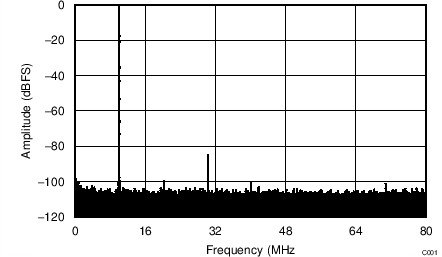
| fS = 160 MSPS, SNR = 70.3 dBFS, fIN = 10 MHz, SFDR = 84 dBc | ||
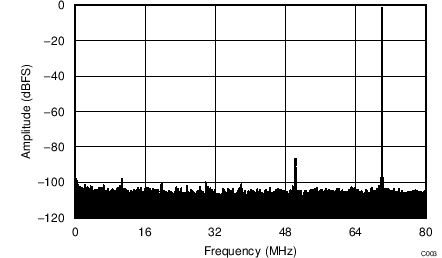
| fS = 160 MSPS, SNR = 69.7 dBFS, fIN = 70 MHz, SFDR = 86 dBc | ||
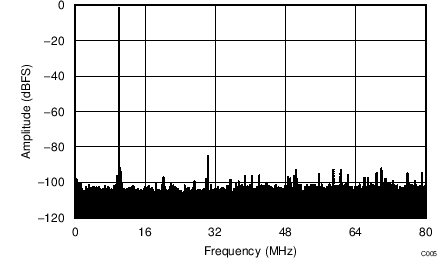
| fS = 160 MSPS, SNR = 67.9 dBFS, fIN = 170 MHz, SFDR = 84.1 dBc |

| fS = 160 MSPS, SNR = 67.0 dBFS, fIN = 270 MHz, SFDR = 76.2 dBc |
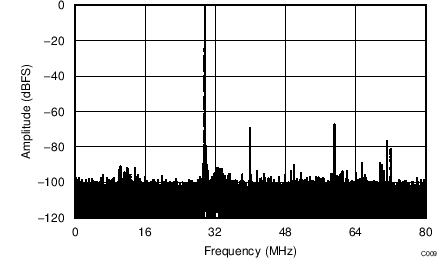
| fS = 160 MSPS, SNR = 62.9 dBFS, fIN = 450 MHz, SFDR = 67.8 dBc |

| fS = 160 MSPS, IMD = 92 dBFS, fIN1 = 46 MHz, fIN2 = 50 MHz, SFDR = 96 dBFS |
(–7 dBFS at 46 MHz and 50 MHz)

| fS = 160 MSPS, IMD = 87 dBFS, fIN1 = 185 MHz, fIN2 = 190 MHz, SFDR = 90 dBFS |
(–7 dBFS at 185 MHz and 190 MHz)

(46 MHz and 50 MHz)


Digital Gain and Input Frequency
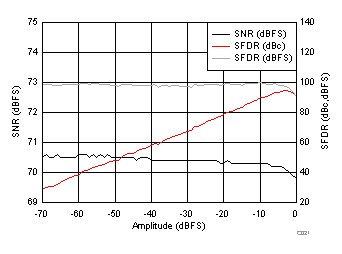
(30 MHz)

(30 MHz)

AVDD Supply and Temperature
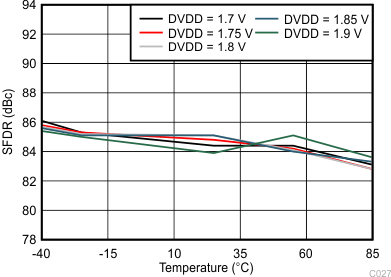
DVDD Supply and Temperature

(40 MHz)
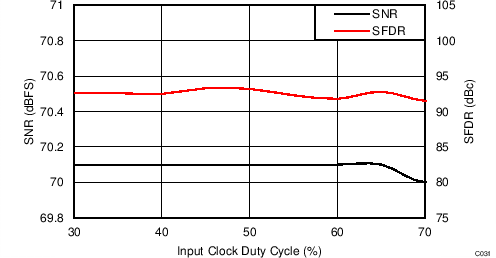
(40 MHz)

| RMS noise = 1.3 LSBs |
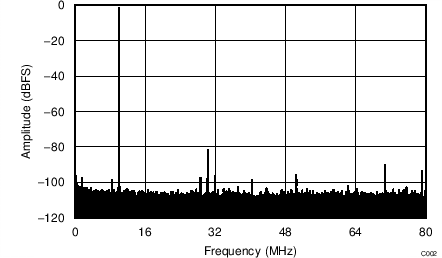
| fS = 160 MSPS, SNR = 70.7 dBFS, fIN = 10 MHz, SFDR = 81.1 dBc |
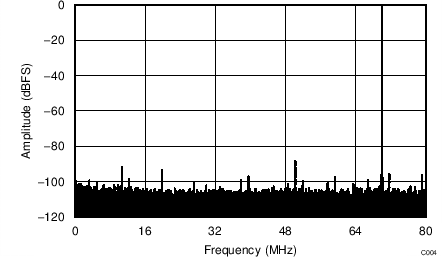
| fS = 160 MSPS, SNR = 70.1 dBFS, fIN = 70 MHz, SFDR = 87.5 dBc |
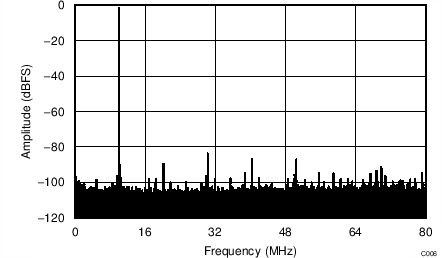
| fS = 160 MSPS, SNR = 68.1 dBFS, fIN = 70 MHz, SFDR = 82.7 dBc |

| fS = 160 MSPS, SNR = 67.5 dBFS, fIN = 270 MHz, SFDR = 75.9 dBc |

| fS = 160 MSPS, SNR = 63.6 dBFS, fIN = 450 MHz, SFDR = 67.6 dBc |

| fS = 160 MSPS, IMD = 98 dBFS, fIN1 = 46 MHz, fIN2 = 50 MHz, SFDR = 102 dBFS |
(–36 dBFS at 46 MHz and 50 MHz)

| fS = 160 MSPS, IMD = 98 dBFS, fIN1 = 185 MHz, fIN2 = 190 MHz, SFDR = 102 dBFS |
(–36 dBFS at 185 MHz and 190 MHz)

(185 MHz and 190 MHz)

Input Frequency

Digital Gain and Input Frequency

(170 MHz)
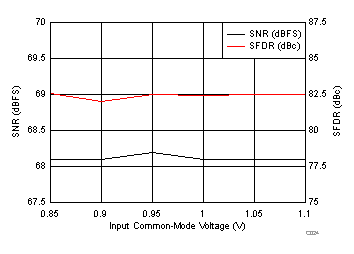
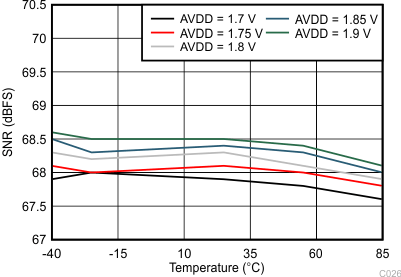
AVDD Supply and Temperature

DVDD Supply and Temperature
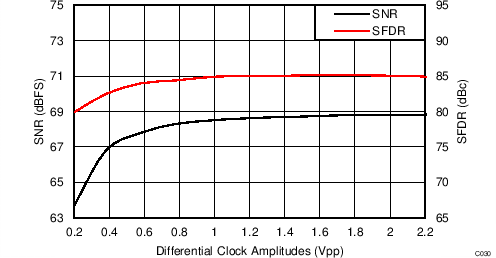
(150 MHz)

(150 MHz)
7.16 Typical Characteristics: ADC34J24
Typical values are at TA = 25°C, ADC sampling rate = 125 MSPS, 50% clock duty cycle, AVDD = DVDD = 1.8 V, –1-dBFS differential input, 2-VPP full-scale, and 32k-point FFT, unless otherwise noted.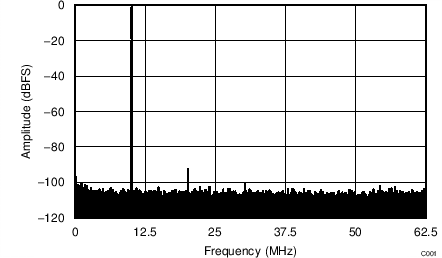
| fS = 125 MSPS, SNR = 70.3 dBFS, fIN = 10 MHz, SFDR = 91.3 dBc |
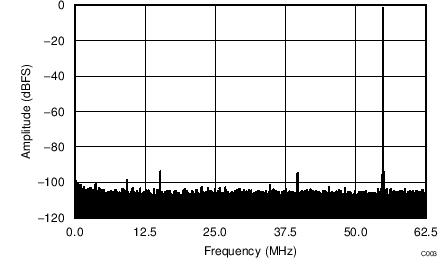
| fS = 125 MSPS, SNR = 70 dBFS, fIN = 70 MHz, SFDR = 93.5 dBc | ||

| fS = 125 MSPS, SNR = 69 dBFS, fIN = 170 MHz, SFDR = 85.9 dBc |

| fS = 125 MSPS, SNR = 68.4 dBFS, fIN = 270 MHz, SFDR = 79.8 dBc |

| fS = 125 MSPS, SNR = 65.2 dBFS, fIN = 450 MHz, SFDR = 62.9 dBc |

| fS = 125 MSPS, IMD = 93 dBFS, fIN1 = 46 MHz, fIN2 = 50 MHz, SFDR = 97 dBFS |
(–7dBFS at 46 MHz and 50 MHz)

| fS = 125 MSPS, IMD = 89 dBFS, fIN1 = 185 MHz, fIN2 = 190 MHz, SFDR = 92 dBFS |
(–7 dBFS at 185 MHz and 190 MHz)

(46 MHz and 50 MHz)
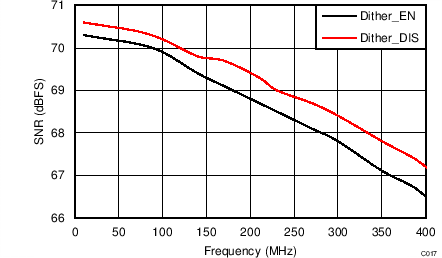

Digital Gain and Input Frequency
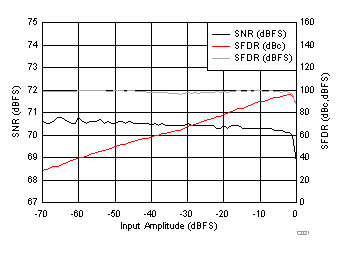
(30 MHz)

(30 MHz)
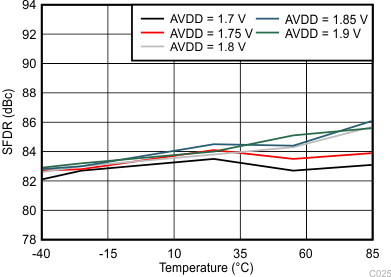
AVDD Supply and Temperature

DVDD Supply and Temperature
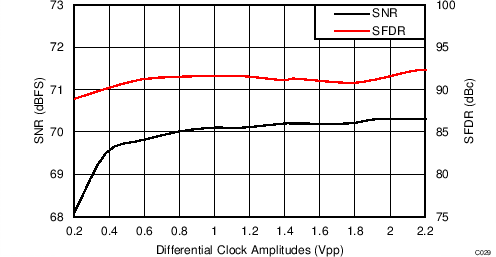
(40 MHz)

(40 MHz)

| RMS noise = 1.4 LSBs |

| fS = 125 MSPS, SNR = 70.5 dBFS, fIN = 10 MHz, SFDR = 90.9 dBc |

| fS = 125 MSPS, SNR = 70.3 dBFS, fIN = 70 MHz, SFDR = 94.3 dBc |

| fS = 125 MSPS, SNR = 69.6 dBFS, fIN = 70 MHz, SFDR = 86.5 dBc |

| fS = 125 MSPS, SNR = 68.8 dBFS, fIN = 270 MHz, SFDR = 79.6 dBc |

| fS = 125 MSPS, SNR = 66.1 dBFS, fIN = 450 MHz, SFDR = 63.1 dBc |
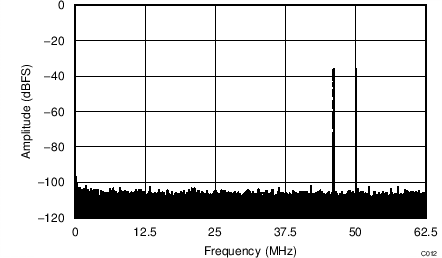
| fS = 125 MSPS, IMD = 101 dBFS, fIN1 = 46 MHz, fIN2 = 50 MHz, SFDR = 106 dBFS |
(–36 dBFS at 46 MHz and 50 MHz)
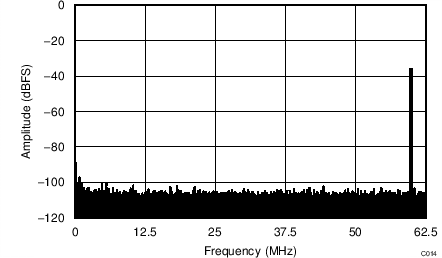
| fS = 125 MSPS, IMD = 99 dBFS, fIN1 = 185 MHz, fIN2 = 190 MHz, SFDR = 103 dBFS |
(–36 dBFS at 185 MHz and 190 MHz)
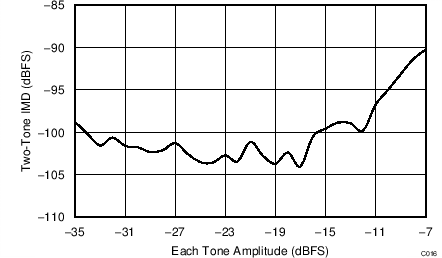
(185 MHz and 190 MHz)

Input Frequency

Digital Gain and Input Frequency

(170 MHz)


AVDD Supply and Temperature

DVDD Supply and Temperature

(150 MHz)
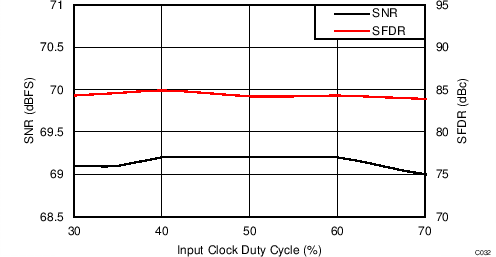
(150 MHz)
7.17 Typical Characteristics: ADC34J23
Typical values are at TA = 25°C, ADC sampling rate = 80 MSPS, 50% clock duty cycle, AVDD = DVDD = 1.8 V, –1-dBFS differential input, 2-VPP full-scale, and 32k-point FFT, unless otherwise noted.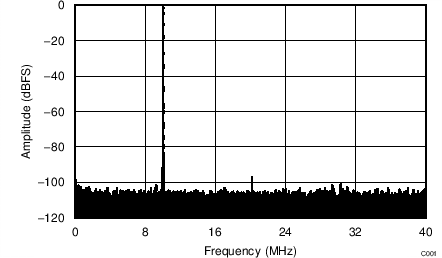
| fS = 80 MSPS, SNR = 70.3 dBFS, fIN = 10 MHz, SFDR = 96.6 dBc |

| fS = 80 MSPS, SNR = 70 dBFS, fIN = 70 MHz, SFDR = 99.5 dBc |

| fS = 80 MSPS, SNR = 69.3 dBFS, fIN = 170 MHz, SFDR = 92.7 dBc |

| fS = 80 MSPS, SNR = 68.4 dBFS, fIN = 270 MHz, SFDR = 76.4 dBc |

| fS = 80 MSPS, SNR = 65.5 dBFS, fIN = 450 MHz, SFDR = 63.3 dBc |

| fS = 80 MSPS, IMD = 95 dBFS, fIN1 = 46 MHz, fIN2 = 50 MHz, SFDR = 99 dBFS |
(–7 dBFS at 46 MHz and 50 MHz)

| fS = 80 MSPS, IMD = 88 dBFS, fIN1 = 185 MHz, fIN2 = 190 MHz, SFDR = 94 dBFS |
(–7 dBFS at 185 MHz and 190 MHz)
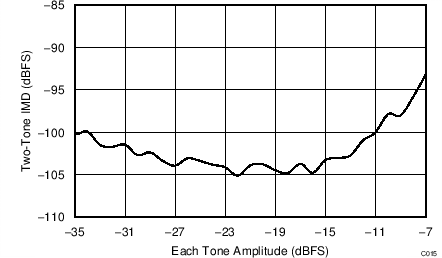
(46 MHz and 50 MHz)


Digital Gain and Input Frequency

(30 MHz)

(30 MHz)

AVDD Supply and Temperature
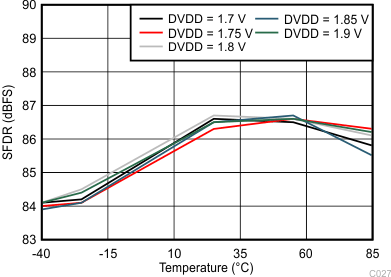
DVDD Supply and Temperature

(40 MHz)

(40 MHz)

| RMS noise = 1.4 LSBs |
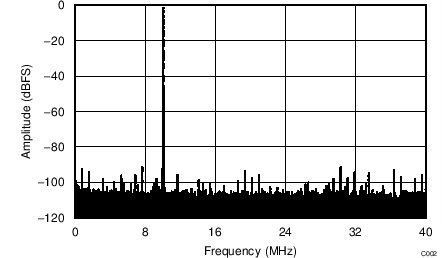
| fS = 80 MSPS, SNR = 70.6 dBFS, fIN = 10 MHz, SFDR = 90.3 dBc |
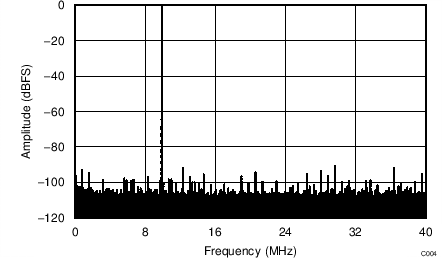
| fS = 80 MSPS, SNR = 70.4 dBFS, fIN = 70 MHz, SFDR = 90.1 dBc |
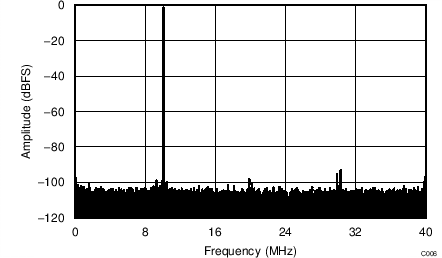
| fS = 80 MSPS, SNR = 69.6 dBFS, fIN = 10 MHz, SFDR = 92.9 dBc | ||
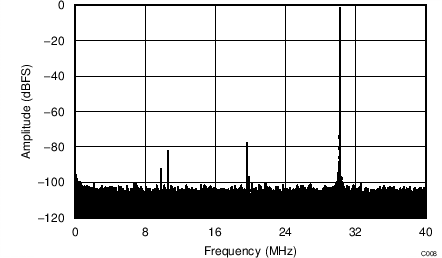
| fS = 80 MSPS, SNR = 68.3 dBFS, fIN = 270 MHz, SFDR = 76.9 dBc |

| fS = 80 MSPS, SNR = 66.2 dBFS, fIN = 450 MHz, SFDR = 62.9 dBc |

| fS = 80 MSPS, IMD = 101 dBFS, fIN1 = 46 MHz, fIN2 = 50 MHz, SFDR = 106 dBFS |
(–36 dBFS at 46 MHz and 50 MHz)
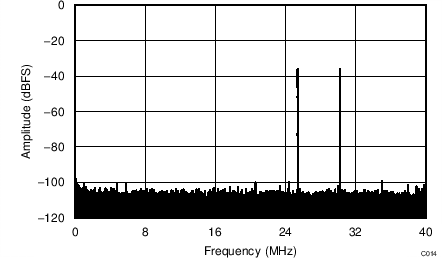
| fS = 80 MSPS, IMD = 100 dBFS, fIN1 = 185 MHz, fIN2 = 190 MHz, SFDR = 102 dBFS |
(–36 dBFS at 185 MHz and 190 MHz)

(185 MHz and 190 MHz)

Input Frequency
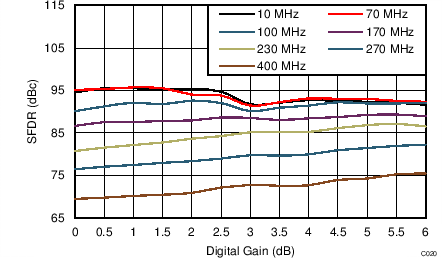
Digital Gain and Input Frequency

(170 MHz)
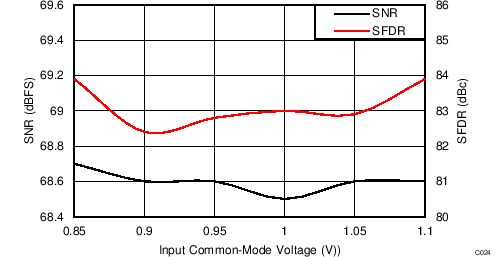
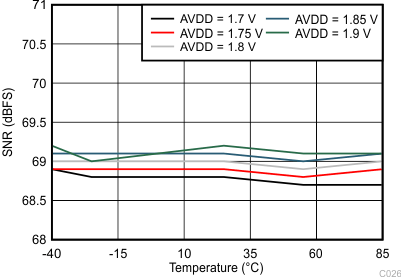
AVDD Supply and Temperature
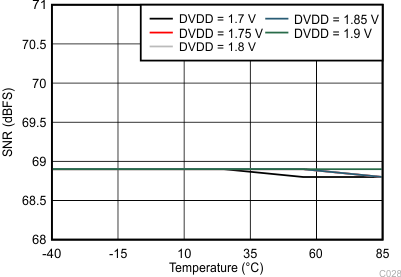
DVDD Supply and Temperature

(150 MHz)

(150 MHz)
7.18 Typical Characteristics: ADC34J22
Typical values are at TA = 25°C, ADC sampling rate = 50 MSPS, 50% clock duty cycle, AVDD = DVDD = 1.8 V, –1-dBFS differential input, 2-VPP full-scale, and 32k-point FFT, unless otherwise noted.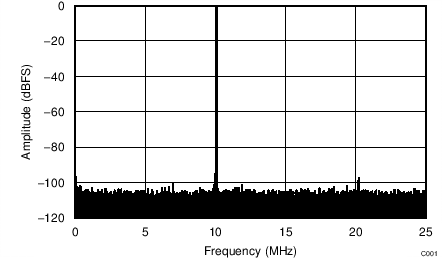
| fS = 50 MSPS, SNR = 70.2 dBFS, fIN = 10 MHz, SFDR = 96.5 dBc |

| fS = 50 MSPS, SNR = 69.9 dBFS, fIN = 70 MHz, SFDR = 92.6 dBc |

| fS = 50 MSPS, SNR = 69.3 dBFS, fIN = 170 MHz, SFDR = 88.7 dBc |

| fS = 50 MSPS, SNR = 68.3 dBFS, fIN = 270 MHz, SFDR = 76.9 dBc |
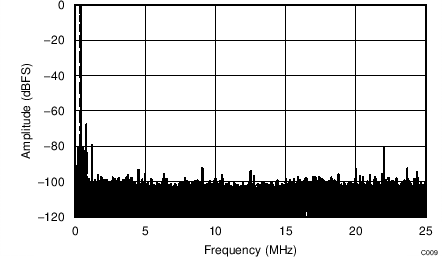
| fS = 50 MSPS, SNR = 66.1 dBFS, fIN = 450 MHz, SFDR = 63.1 dBc |

| fS = 50 MSPS, IMD = 93 dBFS, fIN1 = 46 MHz, fIN2 = 50 MHz, SFDR = 96 dBFS |
(–7dBFS at 46 MHz and 50 MHz)

| fS = 50 MSPS, IMD = 86 dBFS, fIN1 = 185 MHz, fIN2 = 190 MHz, SFDR = 92 dBFS |
(–7 dBFS at 185 MHz and 190 MHz)

(46 MHz and 50 MHz)


Digital Gain and Input Frequency
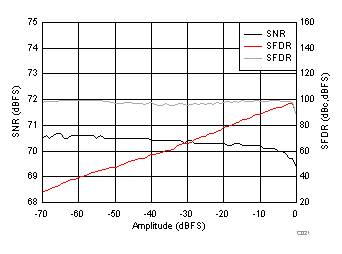
(30 MHz)

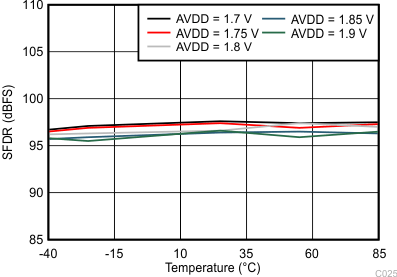
AVDD Supply and Temperature
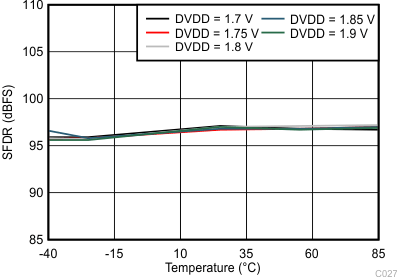
DVDD Supply and Temperature

(40 MHz)
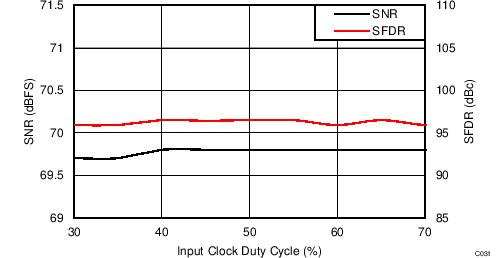
(40 MHz)
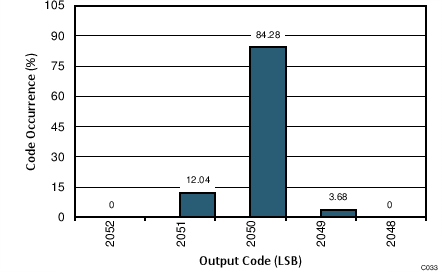
| RMS noise = 1.3 LSBs |
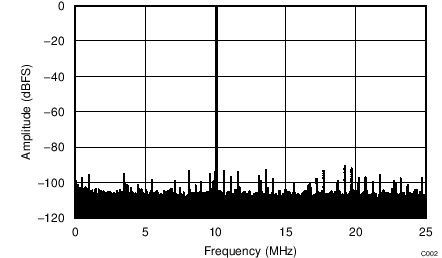
| fS = 50 MSPS, SNR = 70.6 dBFS, fIN = 10 MHz, SFDR = 90.4 dBc |

| fS = 50 MSPS, SNR = 70.3 dBFS, fIN = 70 MHz, SFDR = 88 dBc |

| fS = 50 MSPS, SNR = 69.5 dBFS, fIN = 170 MHz, SFDR = 88.5 dBc |
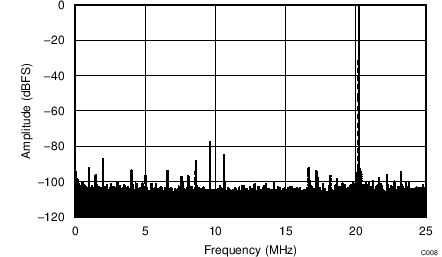
| fS = 50 MSPS, SNR = 68.4 dBFS, fIN = 270 MHz, SFDR = 76.5 dBc |

| fS = 50 MSPS, SNR = 66.3 dBFS, fIN = 450 MHz, SFDR = 63.2 dBc |

| fS = 50 MSPS, IMD = 99 dBFS, fIN1 = 46 MHz, fIN2 = 50 MHz, SFDR = 106 dBFs |
(–36 dBFS at 46 MHz and 50 MHz)

| fS = 50 MSPS, IMD = 99 dBFS, fIN1 = 185 MHz, fIN2 = 190 MHz, SFDR = 102 dBFs |
(–36 dBFS at 185 MHz and 190 MHz)
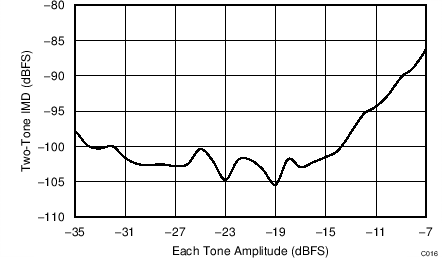
(185 MHz and 190 MHz)
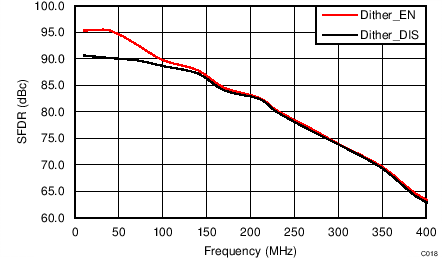
Input Frequency
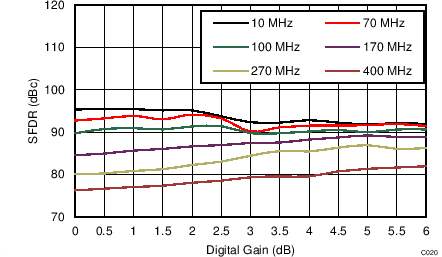
Digital Gain and Input Frequency

(170 MHz)
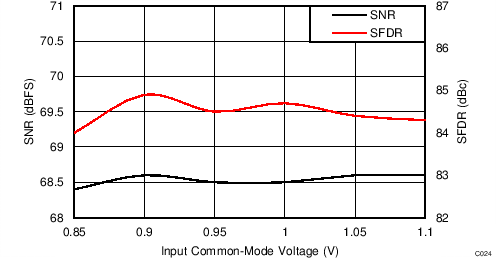
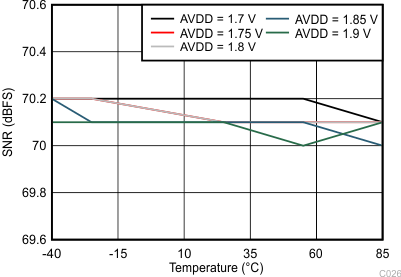
AVDD Supply and Temperature

DVDD Supply and Temperature

(150 MHz)

(150 MHz)
7.19 Typical Characteristics: Common Plots
Typical values are at TA = 25°C, ADC sampling rate = 160 MSPS, 50% clock duty cycle, AVDD = DVDD = 1.8 V, –1-dBFS differential input, 2-VPP full-scale, and 32k-point FFT, unless otherwise noted.
| fS = 160 MSPS, fCM = 10 MHz, 50 mVPP, fIN = 30 MHz, Amplitude (fIN + fCM ) = –98 dBFS, Amplitude (fIN – fCM ) = –91 dBFS |

| fS = 160 MSPS, fPSRR = 5 MHz, 50 mVPP, fIN = 30 MHz, Amplitude (fIN + fPSRR ) = –62 dBFS, Amplitude (fIN – fPSRR ) = –65.35 dBFS |
AVDD Supply
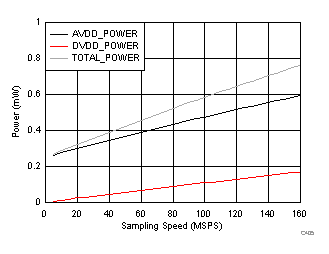
(20x Mode)

| Input frequency = 30 MHz, 50-mVPP signal superimposed on VCM | ||
Test Signal Frequency

| Input frequency = 30 MHz, 50-mVPP signal superimposed on VCM | ||
Test Signal Frequency
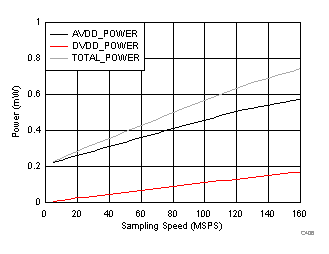
(40x Mode)
7.20 Typical Characteristics: Contour Plots
Typical values are at TA = 25°C, 50% clock duty cycle, AVDD = DVDD = 1.8 V, –1-dBFS differential input, 2-VPP full-scale, and 32k-point FFT, unless otherwise noted.
